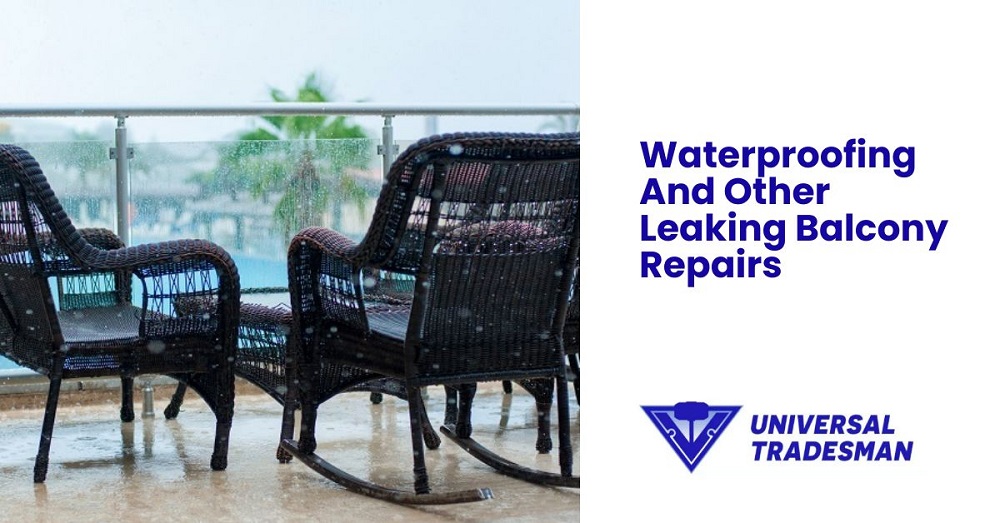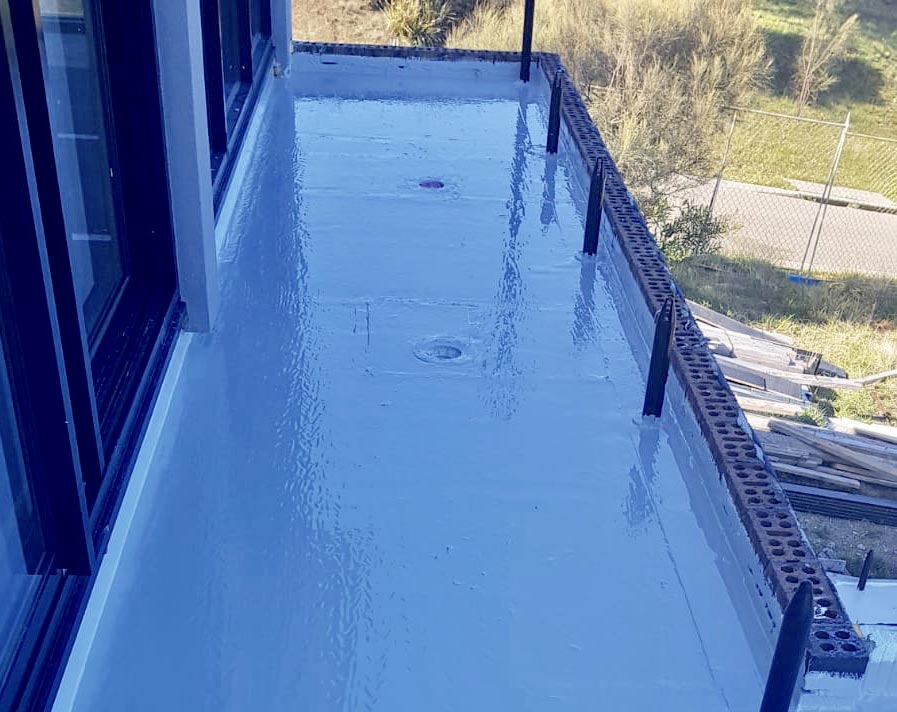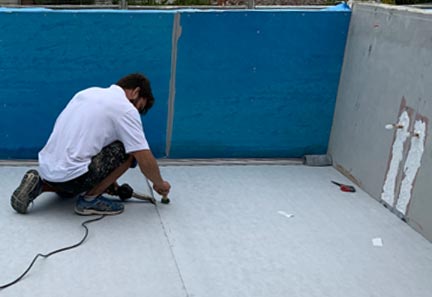

A balcony is essentially a stunning addition to any home. At the touch of your fingertips, it provides a gateway into the outdoors and a portal to getting fresh air without having to leave the house. Additionally, the balcony or balconies attached to your property play an immense role in the visual appeal of the building.
Balconies are frequently used throughout the warmer months of the year and provide appreciated access to nature lovers and individuals looking for respite at different times of the day. However, because balconies are directly exposed to the elements day and night, they face heightened damage and deterioration due to where they are located.
There are many reasons balcony repairs may become necessary; however, regardless of the cause, using the services of experts is essential. Concrete balcony restoration and wood balcony repair require exceptional expertise and skills to ensure the project will be completed within building codes and on time.
Balcony leaks can be devastating and in the long term, lead to structural issues. Not addressing leaking balcony repairs for a significant period could become quite a costly venture that complete damages the plaster and the paint. This article will explore causes of balcony leaks and different types of leaking balcony repairs.
The majority of balconies will leak at some point during its lifespan. Over the years, construction and waterproofing techniques have considerably changed and this has impacted the usefulness of waterproofing membranes. A lot of balconies are being built with insignificant falls to the substrate, particularly in multi-level apartments.
This type of balcony with its minimal fall becomes susceptible to “ponding,” which is basically the water pooling and moisture forming in between the tiles and membrane. If the applied waterproofing membrane cannot endure ponding water, the membrane will break down over time, resulting in leaks. Furthermore, waterlogging can lead to joint failure that causes the balcony to leak.
Below are some of the most common causes of leaky balconies:
• Balcony Membrane Failure
Waterproofing membrane is basically a sheet that is placed above or below the surface to stop water from seeping through the structure. Typically, they are made from materials like rubber, bitumen and polymers. Generally, membranes have a lifespan of 5 to 10 years after being installed and are a measure for waterproofing balconies.
• Broken Surfaces
Cracks in the surface such as those in concrete, grout or tiles are very common causes of leaks on the balcony. These cracks will allow water to pass through and this will eventually be damaging to the structure. Typically, the break is easy to repair by using grout. When the repair work is completed, the whole surface should be sealed. Broken or dislodged tiles would call for the work of professional tilers to repair or replace them. A sealer would still be crucial after the tiles are fixed and the product can be applied by the tilers.
• Porous Masonry Surface
Concrete, tiles, grout and other such masonry materials are not waterproof. Since they are porous by nature, the membrane of these materials can be penetrated by water. Unless a sealer is used on these surfaces, water will seep through and eventually compromise the structure.
• Structural Movement
Building contraction and expansion take place when a building cools down and heats up. Additionally, it happens when building materials is saturated by water. Over time, as the building contracts and expands, it results in structural breaks. These movements could cause the membrane to tear or warp. As such, balconies typically need expansion joints, which are basically flexible joints that enable building movement.

• Efflorescence Expansion
Water causes contraction and expansion of masonry substrates as well. This happend through a process known as efflorescence. Efflorescence is essentially the white crystalline streaks typically visible on masonry surfaces. These are usually formed whenever a masonry surface is saturated by water and the minerals and salts in the masonry dissolve. As the water moves through the masonry, the minerals and salt cause cracks and leaks.
Others include:
• No building maintenance.
• Lack of pre-construction planning.
• Lack of drainage.
• Breakdown of membranes caused by rainwater.
In the preparation stage, before constructing balconies, it is essential for proper care to be applied. Becoming acquainted with correctly installing components, and using proper membranes as outlined in existing building and manufacturing codes, is vital to ensuring a long-term solution to a leaky balcony. When contractors, builders or homeowners take shortcuts or are not skilled in the correct coordination of waterproofing installations, potential health risks and damage could take place. Included among these risks are:
• The structure of the building and balcony being damaged, which could result in breakdown or collapse.
• Disputes between home owners or neighbours and landlords, possibly leading to litigation.
• High costs to re-install membranes and related finishes.
• Mold formation which could result in serious health risks.
These risks could all lead to numerous challenges. These include health and safety hazards, reduction in property value and financial loss.
Taking out grout and using epoxy grout will provide a superior seal for the surface. However, it should be noted that while this is the least expensive option, it is not usually guaranteed to work. This type of service is engineered to stop leaks on patios and balconies without needing to remove tiles. Nowadays, calcite formation and remedy efflorescence that are found throughout many patios, stair construction and balcony courtyard is the second most popular building defect following waterproofing failure.
The epoxy regrouting process prevents ingress at the source, via the grout joints. This procedure prevents saturation underneath the tiles, over time contributing to the leeching and egress of calcite and efflorescence formation. Additionally, the saturation is causing the original waterproof membrane to emulsify.

Based on insurance statistics, the greatest number of waterproofing catastrophes take place with terraces and balconies. Even though the design standards in several of these structures are deficient in the appreciation for water control, a waterproofing membrane is not always the cause for leaking balconies. Without properly inspecting or planning the structure, leaky balconies can have dreadful consequences. As such, this should be concerning to all builders and homeowners.
There are many reasons the waterproof membrane application could ultimately emulsify or fail, resulting in structural damage, expensive repairs and stress and heartache. These include:
• Re-emulsification
• Building movement
• Ponding or constant moisture,
• Contractor lacking experience for the application
• Time and cost factors
There are times when external water proofing fails and swells the ground, causing tiles to crack. Additionally, calcium sometimes pours through the tile adhesive and the edging of the tiles is stained.
When addressing this failure, it is important to waterproof the surface prior to the laying of the tiles by professional tilers. This could be done to a cement sheeting or screed, based on the foundation. In addition, before the tiles are laid, it is important to flash the edges as well. Incorrect perimeter flashing details are among the dominant causes of water infiltration. Caulking all the relevant places is also important to creating a water-tight seal.
Other steps that should be taken include:
• Completing all penetrating and repairing works before waterproofing
• Completing all water drainage works prior to the application of waterproofing materials.
• Using a suitable membrane material for the structure and design of the balcony.
• Ensuring good drainage is in the balcony levels to prevent the forming of water pools.
• Ensuring penetrating materials are used with an extra sealant to produce an additional seal in the affected area.
Sealing the balcony with waterproofing materials assists in preventing rain and water, the most damaging forces of nature. Whenever water trickles through the spaces between the floorboards, it could produce pressure because of the temperature difference, leading to contraction and expansion of the building materials. This could cause cracks that weaken the structure.
A vital aspect of leaking balcony repairs is using waterproofing membrane above and below the surface to safeguard against moisture. It is crucial that water is properly directed away from the area. This is to prevent water from standing and seeping into the surface.
This is a draining technique that helps with the reduction of dampness, efflorescence and water seeping into the surface or the tiling. As such, the following strategies must be applied to ensure optimal balcony sealing and prevent corrosion, dampness and water ingression.
After noticing any sign of erosion, dampness or crack in the balcony, repairs should be correctly and professionally done from the very beginning. This will help your balcony to last for a very long time.
Balconies that are framed in wood undergo a high failure rates. There are often leaks that have visible damage on the finishes underneath. Even worse, there is often hidden structural damage from sustained water migration. When the damage to the structure is discovered, it could be too late for just waterproofing remedies to be implemented. On many occasions, wood-framed balconies have been found to be severely rotted.
When this happens, the balcony will have to be completely restored. This indicates the need to actually start from scratch, which includes demolishing the entire surface of the floor and starting over. If the structure is wooden and rotted, this will need to be fixed before it is rebuilt.
Hiring a professional waterproofing service with professional tilers and caulkers is the smartest approach to leaking balcony repairs and balcony restoration. A number of procedures are involved in the repair that can only be carried out by professionals with a particular type of skill set.
These professionals will use the finest waterproofing membrane solution to endure the structural movement of the balcony and ensure that it is safeguarded against the elements. Additionally, they will assess the balcony and if necessary, recommend additional work that could alleviate overflows, drainage and other possible issues.